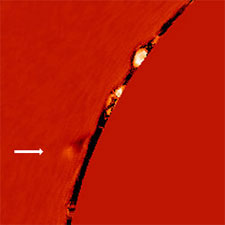STEREO, SOHO spacecraft catch comet diving into sun
By By Robert Sanders, Media Relations, University of California, Berkeley | 26 May 2010
Solar physicists at the University of California, Berkeley, have tracked a comet through the low solar atmosphere, deeper into the sun than ever before, before it presumably evaporated in the 100,000-degree heat.
 |
| Hydrogen-alpha (ultraviolet) observations of the sun's edge from the Coronado instrument of the Mauna Loa Solar Observatory showing what the authors believe to be the comet approaching the solar limb. (Claire Raftery, Juan Carlos Martinez-Oliveros, Samuel Krucker/UC Berkeley) |
Using instruments aboard NASA's twin STEREO spacecraft, four post-doctoral fellows at UC Berkeley's Space Sciences Laboratory were able to track the comet as it approached the sun and estimate an approximate time and place of impact. STEREO (Solar TErrestrial RElations Observatory), launched in 2006, consists of identical spacecraft orbiting the sun, one ahead of Earth and one behind Earth, providing a stereo view of the sun.
The researchers then looked at data from the ground-based Mauna Loa Solar Observatory in Hawaii, and found images in the predicted spot of what appears to be a comet approaching the edge of the sun from behind the solar disk.
"We believe this is the first time a comet has been tracked in 3-D space this low down in the solar corona," said Claire Raftery, a post-doctoral fellow newly arrived at UC Berkeley from Dublin's Trinity College.
Sungrazing comets, composed of dust, rock and ice, are seldom tracked close to the sun because their brightness is overwhelmed by the solar disk. This comet apparently survived the heat of the corona and disappeared in the chromosphere, evaporating in the 100,000-degree (Kelvin) heat.
Raftery and her colleagues, Juan Carlos Martinez-Oliveros, Samuel Krucker and Pascal Saint-Hilaire, concluded that the comet was probably one of the Kreutz family of comets, a swarm of Trojan or Greek comets ejected from their orbit in 2004 by Jupiter, and that it made its first and only loop around the sun. The swarm probably resulted from the disintegration of a larger comet.






























